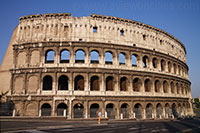Construction on the Colosseum began under Emperor Vespasian (69-79) and was completed under his son Titus (79-81) in 80 AD. It was built on the site of an artificial lake created by Nero in this valley between Rome's many hills, in front of his Domus Aurea palace.
The arena was then known as the Flavian Amphitheatre, after the family name of the emperors who built it. The name "Colosseum" was not used until 7th century, and derives from the colossal statue of Nero that once stood here. After Nero's death, the statue was transformed into a representation of Helios, the sun god. It remained standing until the Middle Ages, when it was probably melted down for its bronze.
The elliptical building is immense, measuring 188m by 156m and reaching a height of more than 48 meter (159 ft). The Colosseum could accommodate some 55,000 spectators who could enter the building through no less than 80 entrances.
Above the ground are four storeys, the upper storey contained seating for lower classes and women.
The lowest storey was preserved for prominent citizens. Below the ground were rooms with mechanical devices and cages containing wild animals. The cages could be hoisted, enabling the animals to appear in the middle of the arena.
Above the ground are four storeys, the upper storey contained seating for lower classes and women.
The lowest storey was preserved for prominent citizens. Below the ground were rooms with mechanical devices and cages containing wild animals. The cages could be hoisted, enabling the animals to appear in the middle of the arena.
The Colosseum was covered with an enormous awning known as the velarium. This protected the spectators from the sun. It was attached to
large poles on top of the Colosseum and anchored to the ground by large ropes. A team of some 1,000 men was used to install the awning.




